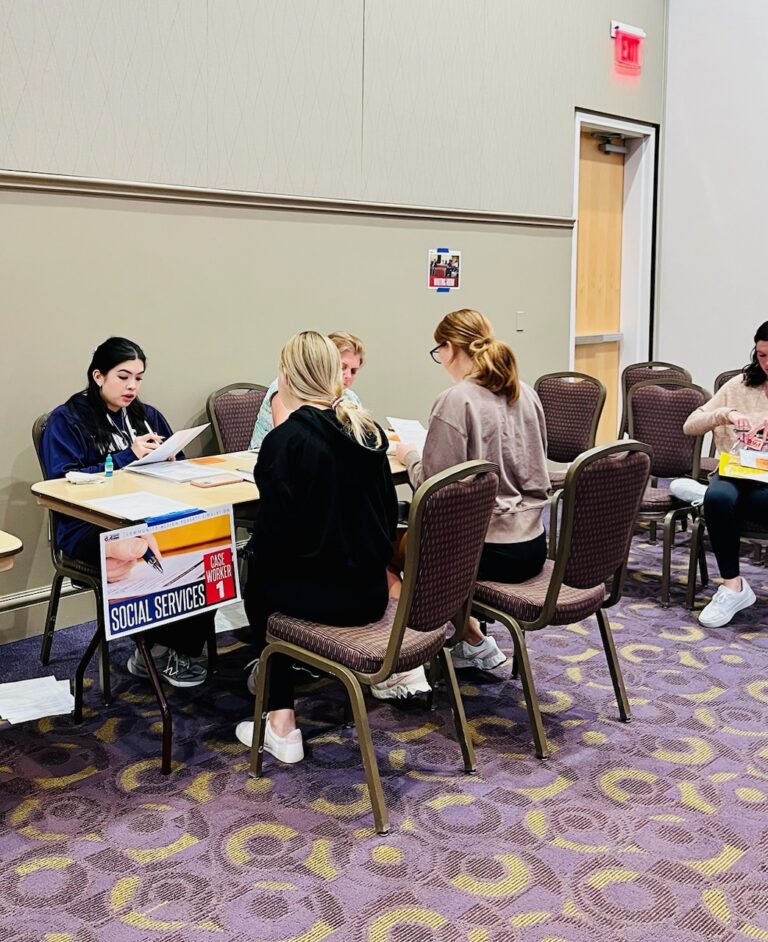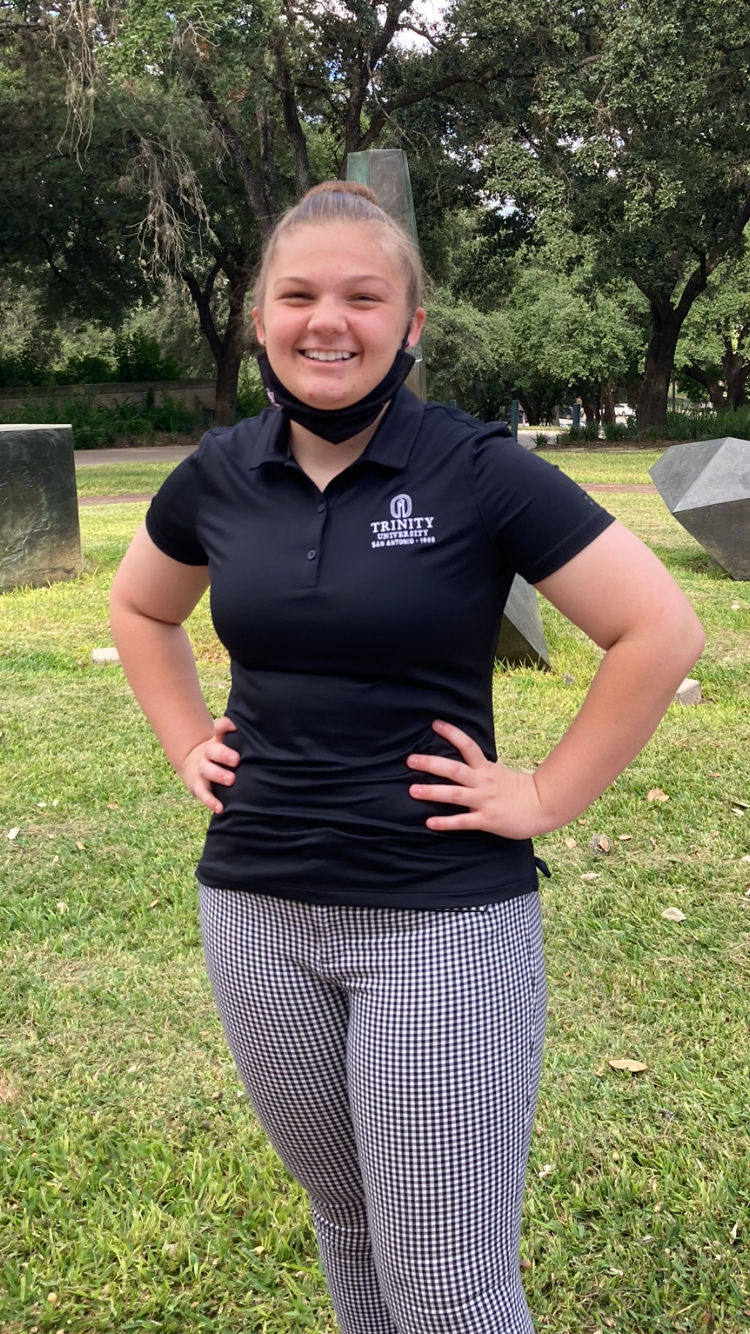
Harris College students recently became sensitized to the day-to-day realities of life faced by people with low incomes through a poverty simulation. The experiment offered students an opportunity to consider how working within interprofessional and interdisciplinary teams might help them to deal more effectively with people living in poverty. The three-hour simulation demonstrated what it’s like to be part of a low-income family surviving month to month. Students were assigned to a family unit and provided with identification documents, possession, sources of income, bills and various other items needed to survive the “month.”
Facilitators reinforced the fact that the experiment was a simulation, not a game. Poverty is not a game for the over 38.1 million people living in poverty, US citizens whose lifestyles were simulated.
- Poverty for a family of four means having an income below $25,780
- 6% of men and 12.9% of women are living in poverty in the US
Participants were asked to be as realistic as possible about their role by thinking like a person facing poverty would think and act like the age and position assigned to them. Here are some of their experiences.
Rayna Webb
Exercise Psychology graduate student
My initial thought going into the simulation was, “This isn’t a simulation, this is my lived experience.”

I’m a first-generation college graduate and recently started the master’s program in exercise psychology here at TCU. I was raised in an extremely low-income household. My situation worsened as I entered middle and continued into high school. I received free or reduced lunch at school. I remember my mother going go to local food banks multiple times a week so she could put food on our table. At one point, my older sister moved back home with us to help take care of bills so we wouldn’t lose our house. As a child, I felt very resentful toward my family for not taking better care of me. But at that time, I didn’t understand the physical and societal barriers that prevent people from achieving upward economic mobility. I believed that my family intentionally let me down and was continuing to keep us down because they weren’t trying hard enough.
In the simulation, I had to look at my situation through the lens of a widowed old man; someone lonely, but also someone who only must provide for himself. While my solidarity made it easier to manage my funds, my persona also faced the challenges of getting pushed around to various help centers without receiving exactly what I needed, along with a lack of compassion from workers tending to me. I was able to get most of what I needed for the month and then return to my “house” in the corner of the room by myself. I did not interact with many other people, nor was I part of a family unit. A faculty member pointed out that my mental health must be suffering from so much isolation, and I agreed. I thought about Maslow’s Hierarchy of Needs and how much of a privilege companionship and the ability to properly manage feelings of grief and loneliness are. Unless my physiological needs like food and shelter are fulfilled, I can’t afford to spend time and energy striving for mental and emotional needs. Through my character’s lens, I was able to better understand the hardships that my family faced in trying to provide the best life they could for me while growing up. Instead of harboring resentment, I can now channel that into compassion and gratitude for their efforts.
It was important for me to experience this simulation from a perspective outside of my own, and I believe this exercise is crucial for those who have never lived this reality.
The poverty simulation has the potential to bridge gaps between students of vastly different socioeconomic backgrounds by creating a level of empathy and understanding for one another.
Ashley Franklin
Polly & Tex Rankin Endowed Professor of Nursing
I helped organize the committee for this year’s poverty simulation, and I was the facilitator during the event and debriefing. I learned about poverty simulation around 2011 while teaching at Oregon Health & Science University, and I was impressed with the representations of poverty of time and resources. I love that poverty simulation is experiential and that our students assume the roles of families that are very similar to patients and clients they encounter in traditional clinical settings.
When I first experienced poverty simulation, I was overwhelmed by the complexity of the setup. There were so many details for families to keep track of like due dates for bills, time spent at work, navigating unexpected situations like illness, and how many families missed meals in a given month because they ran out of time to go to the grocery store.
As a faculty member, I was pleased our students were able to recognize these same challenges and empathize with the complexity of meeting ends meet from the perspective of the patients and clients they serve.
Now that I’ve participated in the simulation several times with a variety of health professions students, one of the new “aha” moments I’ve had relates to how much criminal activity grows over time among simulation participants. At the beginning of the activity, the law enforcement officer doesn’t have a lot to do. Over the course of the activity, there are more crimes like stealing, the use of guns without permits and juvenile delinquency. The sense of increased crime adds stress from the family perspective and on the law enforcement officer. As our students feel the desperation of trying to make ends meet toward the end of the month, some feel tempted to engage in criminal activity. On the flip side, some families naturally band together to help pay bills and protect their elders, which gives me hope for goodness in the world.

Each time I participate in the poverty simulation, I am reminded of how families experiencing or close to poverty are vulnerable financially, especially because they may not have protections from using a commercial bank and so they pay varied check cashing fees. For our students, a common “aha” moment relates to how causal we may be about using a debit card and not requesting a receipt for service because we know there is an account of charges on the debit card. Because our students aren’t accustomed to asking for receipts, they experienced some vulnerability in the simulation when someone questioned if they had paid a mortgage or utility card bill because there was no receipt or paper trail. Another common point that comes up after the simulation relates to the challenge of transportation costs, like gas, insurance, bus passes or ride share. I am thankful our students make connections during this experiment about how barriers to transportation impact our patients’ and clients’ ability to attend appointments on a regular basis and so when they attend, we need to take full advantage of the time they can spend with health care resources.
Poverty simulation as an experiential learning strategy helps increase our students’ empathy towards patients living at our close to poverty. Some families in the simulation start out experiencing homelessness, and other families are evicted from their homes over time. In the simulation, our students get a chance to see first-person how close families live to the margins of experiencing homelessness. Part of the debriefing experience usually uncovers the importance of knowing community resources as well as how and where to ask for help. Our students often learn from each other where to ask for help and how to negotiate for help, which to me is representative of the lived experience of living in or close to poverty.
At the end of the poverty simulation debriefing, we talk about opportunities our students and faculty colleagues recognize for advocacy in their professional roles. After this semester’s simulation, the most common advocacy topics were increasing the minimum wage to a living wage, paying schoolteachers more, gun control, subsidizing medication costs and voting to elect legislators who have political agendas that mitigate gaps in services for patients and clients living at or close to poverty.
This was the first year that a larger total number of students was attempted. Last spring’s simulation had approximately 70 students, this year, there were over 150 students over both nights. The experience was executed over two nights and could not have happened without the faculty and volunteers.
This is the first perspective in a series of three. Read Part Two.